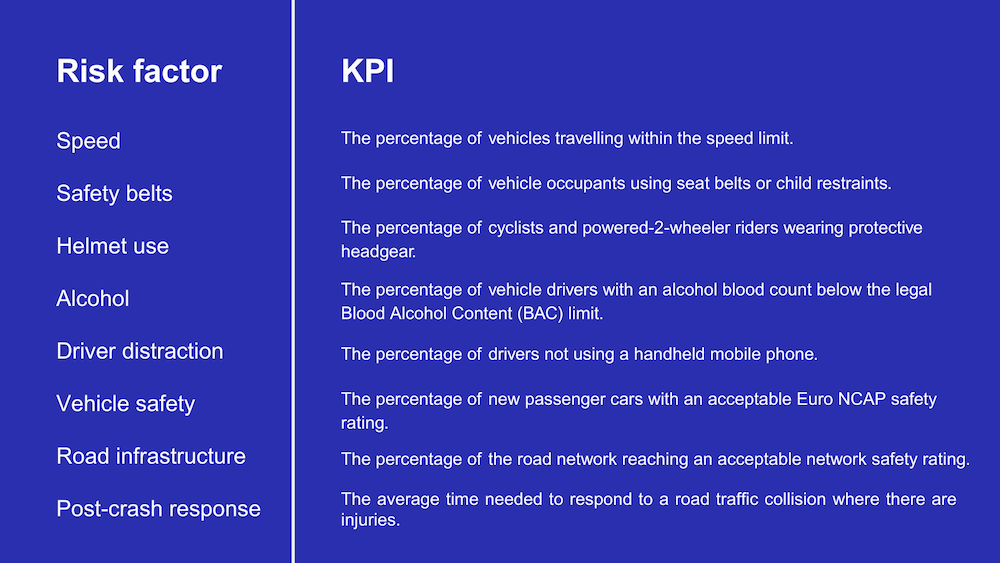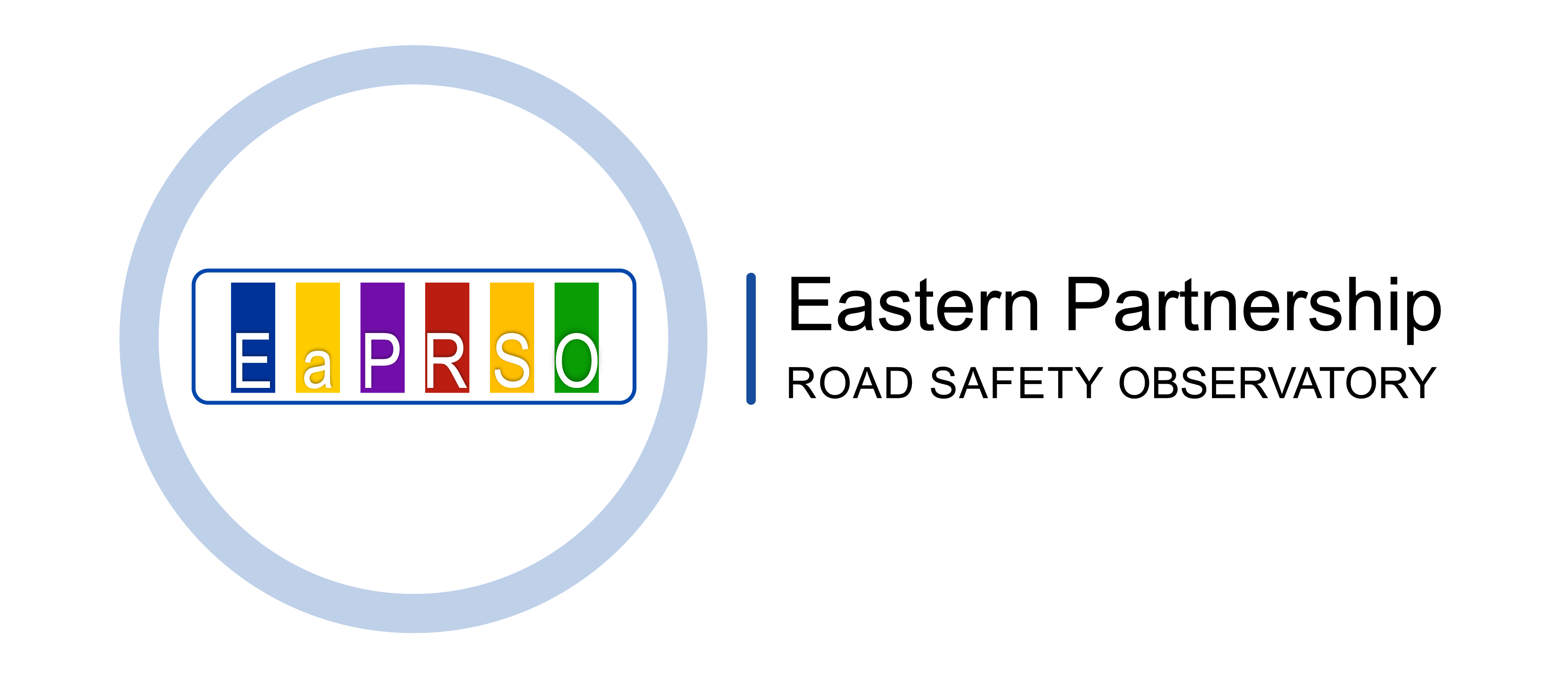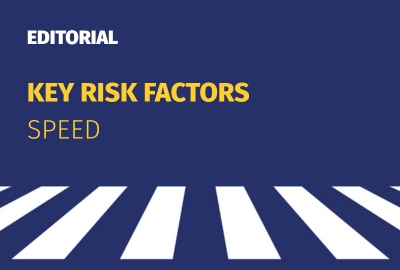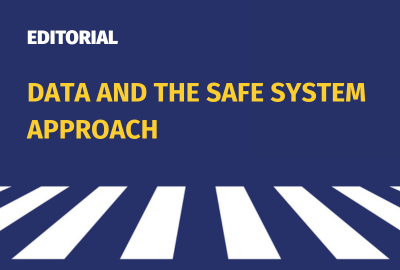
Success in reducing road death and injury requires a systematic approach, involving good road safety management, legislation, safe road engineering, vehicle safety standards, quick and effective response to road crashes and safe behaviour by road users. For any road collision, many factors may be working in deadly combination: for example, poor design that permits inappropriate speed, bad weather, mixed with fatigue and poor visibility.
In 2019, the European Commission published the EU Road Safety Policy Framework 2021-2030, which identifies eight Key Performance Indicators (KPIs) targeting common road risk factors that ought to be measured and addressed by Member States. These include:

These KPIs are recognised to be important measures of the safety performance of a country or region. However, they are only an initial step, with the EU continuing to add additional indicators over time. This aims to facilitate evidence-based road safety interventions, moving country reporting beyond simple crash and casualty counts and enabling meaningful analysis of road safety performance.
Those managing road safety are encouraged to keep up-to-date information on how they are performing under each indicator, and to use this information as a benchmark for improvements.
However, in practice, in many countries meaningful data is not collected on these important indicators – or if it is collected, it may be patchy or irregular. One of the goals of the EaP RSO, therefore, is to support our member countries in establishing sustainable practices for improved data collection against these KPIs, with current projects focused on collecting data on seat belt use in Armenia and Moldova.
We know that seat belt use saves lives. Wearing a seat belt cuts the likelihood of dying in a road crash by 50%. Ensuring that vehicle passengers use their safety belts is one of the most effective and cost-effective measures a country can employ to cut the number of road fatalities and serious injuries. But many countries do not regularly monitor seat belt wearing rates, including countries covered by the Eastern Partnership Road Safety Observatory. This makes it difficult to know the extent of the problem, or to measure the success of policies to promote seat belt use.
Most often, seat belt wearing rates are estimated by traffic police from information collected at the scene of a road crash. However, this approach does not adequately measure the proportion of vehicle drivers and passengers who use seat belts overall and may give an inaccurate picture of true wearing rates. Indeed, it does not account for the fact that people involved in crashes may not be representative of the population as a whole – perhaps they are more likely to be risk-takers. In addition, it is possible that injured persons may climb out of the vehicle and may not be truthful in reporting whether they had been wearing a seat belt (particularly if the law requires it). Lastly, collecting data on seat belt use may simply not be prioritised and so it goes unrecorded. For example, in 2019 the UK police recorded that in 49% of road crashes the information on seat belt use was “unknown.”
To collect meaningful information on seat belt wearing rates, a number of alternative approaches may be used instead to give more meaningful and useful data.
- Roadside observational surveys
These involve teams of trained observers conducting observations in locations representative of traffic patterns nationally, regionally or locally. Observations should be conducted at different times of day and on different days of the week to capture different behaviour patterns. For example, commuters may be more likely to wear seat belts than people driving for leisure. The number of observations made is also important: the smaller the number of observations, the less reliable the results. Such observational surveys can be carried out by Traffic Police, civil society organisations, or academic researchers.
- Video camera images of drivers and front passengers
Where video cameras record traffic, it is also possible to review video footage and count the numbers of front seat passengers wearing belts. The same considerations apply for selecting times, locations and samples. While this may be easier for public authorities to do, this method does have drawbacks. Cameras may only be located on certain classes of road (such as motorways), and it is normally impossible to view back seat passengers.
- Self-reporting in anonymous road user surveys (such as ESRA).
It is also possible to collect data using population surveys, where participants self-report their behaviour and attitudes. The best example of this is ESRA, the E-Survey of Road Users’ Attitudes, an international initiative collecting data in 68 countries. This anonymous, self-reported data gives a valuable insight into attitudes and behaviour which can help policy makers. For example, through ESRA, we know that in 2023 seat belt wearing of front seat passengers in Slovenia was relatively good. Just 10% of car passengers reported non-use of seat belts in the previous 30 days – better than the EU average of 15%. But back seat wearing rates remained poor, with one third admiting to not wearing a seat belt in the back of vehicles. Their attitudes were relatively relaxed about the acceptability of non-use of seat belts, on average a rating of 2.8 on a scale of 1 (unacceptable) to 5 (acceptable). Such data can be used to target initiatives focused specifically on seat belt wearing in back seats, with targets to address the acceptability of non-use.
Unfortunately, however, for EaP RSO member countries, only Armenia participates in the ESRA survey, and they have not registered any data on seat belt use. As such, the EaP Road Safety Observatory is facilitating important studies on seat belt usage in Armenia as well as on wider risk factors in Moldova. We are currently supporting a comprehensive baseline assessment of seatbelt usage in Yerevan to identify opportunities to enhance national road safety efforts, and assisting the Moldovan Government in achieving its goals for quantifying, addressing and monitoring road user behaviour risk. More information on the outcomes of these initiatives will be published in early 2026.




